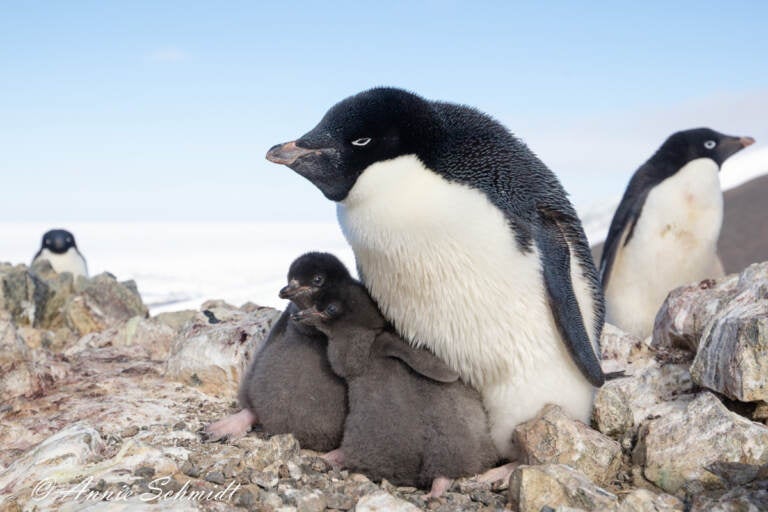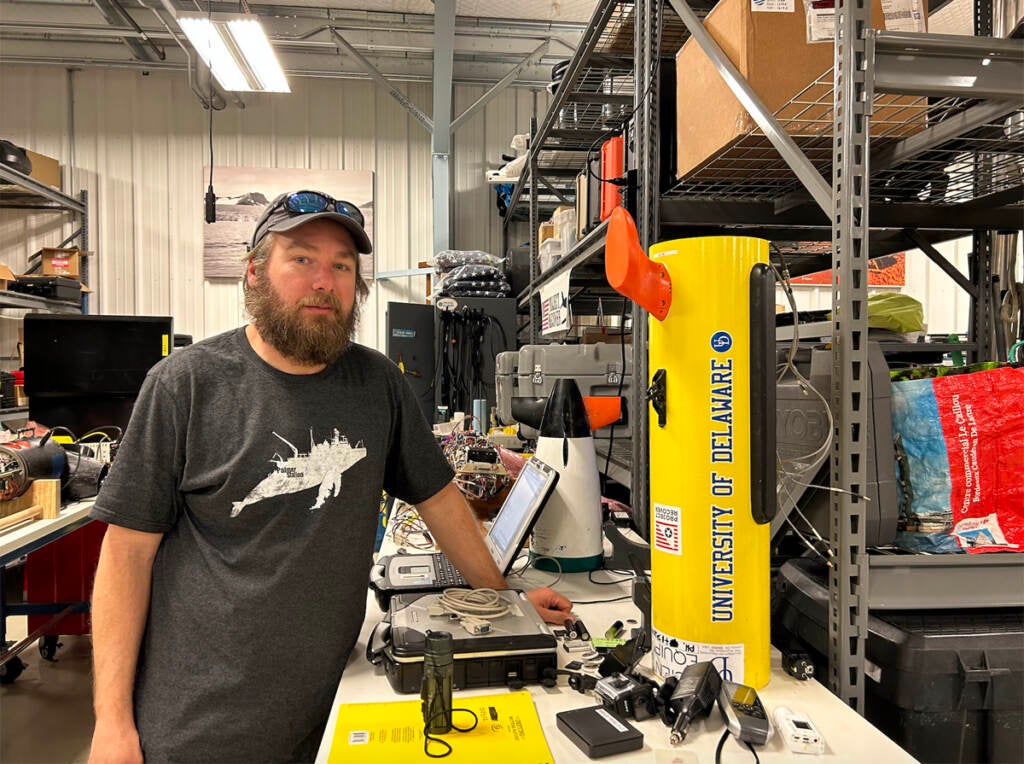One penguin species declines, while another thrives on the western Antarctic Peninsula
Scientists predict that Adélie penguins could disappear from the western Antarctic Peninsula. Researchers at UD and Temple are tracking the changing conditions.
Listen 13:55
An Adélie penguin with two chicks on Ross Island, Antarctica. (Annie Schmidt/Point Blue)
This story is part of the WHYY News Climate Desk, bringing you news and solutions for our changing region.
From the Poconos to the Jersey Shore to the mouth of the Delaware Bay, what do you want to know about climate change? What would you like us to cover? Get in touch.
The Antarctic Peninsula is heading into winter. That means the day length is shrinking, and the temperatures are dropping.
Black and white Adélie penguins rest on patches of floating sea ice. Gentoo penguins, with their bright orange beaks and flippers, hang out on rocky islands and dive into the chilly water, hunting for shrimp-like krill and small fish.
Penguins swimming under water from newsroom on Vimeo.
Things are changing for these two closely related species.
Adélie penguin populations on the western side of the Antarctic Peninsula have declined dramatically in recent decades, while gentoo penguins there have become more plentiful. In other parts of Antarctica, Adélie colonies have grown.
As conditions are shifting, scientists are racing to figure out how the penguins’ numbers are responding and why.

‘Some parts are warming fast. Some not so much’
The Antarctic Peninsula — a piece of land that juts up from the continent toward South America — has experienced some of the fastest warming on earth.
“I’ve actually witnessed the receding of all the glaciers, the appearance of all these new islands coming up,” said Mark Moline, a professor of marine studies at the University of Delaware who visited a research station near the western Antarctic Peninsula between the early 1990s and 2011.
Since the 1950s, the Antarctic Peninsula has very likely experienced a “strong” warming trend, according to the Intergovernmental Panel on Climate Change. In the late 1990s, the peninsula entered a cooling period, which scientists consider within the range of natural variability. But in the last few years, the peninsula has started warming again, with above-average melt seasons the last two years.
Subscribe to The Pulse
Global warming, caused by humans burning fossil fuels, is just one factor influencing conditions in Antarctica. The hole in the ozone layer affects wind and weather patterns there, and the continent is subject to lots of natural variability.
In East Antarctica, scientists have even observed cooling.
“It’s a little complex, because Antarctica is a large continent, and there are different amounts of climate change happening in different parts,” said Atsuhiro Muto, a glaciologist at Temple University in Philadelphia. “Some parts are warming fast. Some not so much.”
Investigating ‘an interesting problem’
Megan Cimino, a researcher at the University of California, Santa Cruz, is one of the scientists trying to figure out why Adélie and gentoo penguins are responding so differently to changes on the western Antarctic Peninsula.
“It’s sort of an interesting problem,” she said. “They’re all mainly eating the same food, krill, and they’re breeding relatively close together. … So, how can their populations be doing such different things?”

Cimino works on a long-term research study, where scientists have collected the same sorts of data since the 1990s. She spent the last few months at Palmer Station on Anvers Island, off the western coast of the peninsula, counting penguins in nesting areas, measuring and weighing chicks before they leave their nests, and taping tiny GPS transmitters to adult penguins’ backs to track them as they hunt for food.

Cimino has several ideas about what might be going on.
One has to do with rain and snow. She says there’s some evidence that the Antarctic Peninsula has gotten more precipitation.
Both Adélie and gentoo penguins breed in large colonies. They lay their eggs on bare rock, where they build nests out of small pebbles, so their eggs don’t roll away. If a breeding site is covered in snow when the penguins get there, Cimino says they have two choices: lay their eggs in snow or wait until the snow melts.
Gentoo penguins stay on the same island all year round, so they have some flexibility in when they lay their eggs. Cimino says they can wait until the snow melts.
But the Adélies are on a strict schedule, because they swim out to sea each winter. They can’t be “waiting around forever” for the snow to melt, Cimino said, so they may lay their eggs in it.
Cimino says wet eggs are less likely to hatch. Even if they do, a damp environment can be a problem.
“These chicks don’t have waterproof feathers,” Cimino said. “So, when their feathers do get wet, the chick can get very cold. Then they’re having to expend energy to keep their body warm.”
Another idea about the Adélie penguin decline around the western Antarctic Peninsula has to do with the fact that the amount of sea ice there has been decreasing.
Adélie penguins rely on sea ice, especially during the winter, when they head out to sea. The ice is a place to rest and escape predators. It’s also key to the food web.
“Sea ice can attract a lot of other critters that they eat,” Cimino said. “So it could provide a nice foraging habitat and resting platform.”
On the other hand, gentoo penguins are generally found further from the pole than Adélies — in places with less sea ice, Cimino said.
The Adélie decline could also be related to humans fishing for krill in the waters nearby, Cimino said.

Using robots to find krill
To learn more about the role the penguins’ food plays, Cimino collaborates with other researchers, like Mark Moline at the University of Delaware. Moline leads a study on krill and small fish in the waters near Palmer Station, tracking where these penguin prey are.
“What we’re looking at is the food web that [the penguins] rely on and how that’s changing in response to this sort of larger scale global change and regional change,” Moline said.
This past Antarctic summer, Matthew Breece — an assistant professor at UD working with Moline — collected data around Palmer Station on not only krill, but the phytoplankton and algae the krill eat, too.
“It’s kind of a food web, all the way from the very bottom — light and nutrients — all the way up to the penguins,” Breece said.
The team uses a torpedo-shaped robot equipped with sonar to gather data underwater.
Each day when the weather allows, the researchers venture out in an inflatable boat to release the robot into the ocean. They program it with a mission — for example, to swim in a criss-cross pattern over the top of a deep-water canyon, gathering data for several hours on the world around it.
The robot has sensors to measure a variety of ocean conditions while it looks for penguin prey. These include temperature, salinity, and how much sediment is in the water.
This information helps paint a picture of how the penguin’s food could change as, say, melting glaciers dump more freshwater into the ocean.
“We’re not sure how things are going to respond as climate change goes forward,” Breece said. “So, the more data we have in the current conditions [on] what the penguins are doing, what the penguin food is doing … under different scenarios or different conditions, then we can better predict and better estimate what [the future] may look like.”

Climate change ‘winners’ and ‘losers’
Megan Cimino and other scientists predict that in decades to come, Adélies could disappear from the western Antarctic Peninsula and nearby islands.
“We’ve already seen one … Adélie colony that went extinct. A few of our other colonies on different islands are very close to extinction,” Cimino said. “We’ll see how long they sort of hold out.”
But in other parts of Antarctica, like Ross Island, thousands of miles away from Palmer Station, researchers have seen Adélies thrive.
Ross Island is closer to the pole and colder than the Antarctic Peninsula — too cold for the gentoo penguins. Here, Adélie populations have largely grown or remained stable over the last two decades, said Grant Ballard, chief science officer at Point Blue Conservation Science, a nonprofit research organization that advocates for conservation.
Ballard describes himself as a “die-hard optimist” — and he thinks warming temperatures in Antarctica could create not just problems, but also new opportunities for penguins.
“There’s going to be places where the ecosystem will thrive and … new life will be emerging,” Ballard said.
Steven Emslie, a biology professor at the University of North Carolina, Wilmington, has found ancient penguin mummies on a coastline near where Ballard does his research. Emslie thinks cooling temperatures hundreds of years ago may have made the place uninhabitable for Adélies — but that might not be the case anymore.
“The Adélie penguin’s in this interesting position of being both a climate change loser in the peninsula and a climate change winner in the Ross Sea,” Emslie said. “The gentoo penguin’s a climate change winner in the peninsula, because it prefers open water. It’s a more sub-Antarctic species, and so the warming trend has actually benefited that species.”
Individuality is key to adaptation
In general, Adélie penguins return to the place they were born to lay their first eggs — then keep breeding in that same place every year. This makes it hard for a colony to move as the environment changes.
But, in the nearly 30 years Ballard has been traveling to Antarctica, he’s observed individual differences in penguins. Some leave their chicks alone earlier, others later. Some are fastidious about their pebble nests.
“There’s individuals that are more prickly towards other penguins and others that are sort of nonchalant,” Ballard said. “Others that are very expert at stealing rocks from one another and others that don’t care about rocks.”
Ballard says this individuality could actually be useful in adapting to climate change.
An adventurous youngster could spot a welcoming, rocky breeding ground — exposed by, say, newly melted ice. This bird and a mate could strike out on their own, and start something new.
“There’s a percentage of the population that just does wander and establishes new locations for breeding,” Ballard said. “So, that seems to be part of how evolution works and how adaptation works.”
WHYY is your source for fact-based, in-depth journalism and information. As a nonprofit organization, we rely on financial support from readers like you. Please give today.







